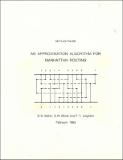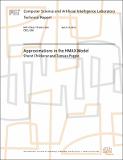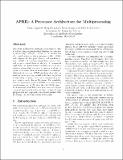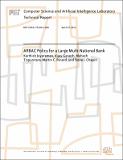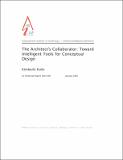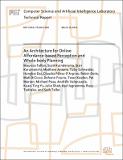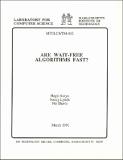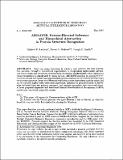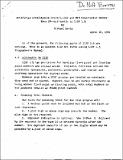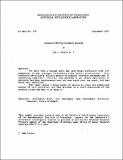Browsing Computer Science and Artificial Intelligence Lab (CSAIL) by Title
Now showing items 194-213 of 3804
-
Approximating Buy-at-Bulk k-Steiner trees
(2005-11-15)In the buy-at-bulk $k$-Steiner tree (or rent-or-buy$k$-Steiner tree) problem we are given a graph $G(V,E)$ with a setof terminals $T\subseteq V$ including a particular vertex $s$ calledthe root, and an integer $k\leq |T|$. ... -
Approximating the Minimum-cost Maximum Flow is P-Complete
(1992-06)We show that it is impossible, in NC, to approximate the value of the minimum-cost maximum flow unless P = NC. -
An Approximation Algorithm for Manhattan Routing
(1983-02)Density has long been known to be an important measure of difficulty for Manhattan routing. In this paper, we identify a second important measure of difficulty, which we call flux. We show that flux, like density, is a ... -
Approximations in the HMAX Model
(2011-04-14)The HMAX model is a biologically motivated architecture for computer vision whose components are in close agreement with existing physiological evidence. The model is capable of achieving close to human level performance ... -
APRIL: A Processor Architecture for Multiprocessing
(1991)Processors in large-scale multiprocessors must be able to tolerate large communication latencies and synchronization delays. This paper describes the architecture of a rapid-context-switching processor called APRIL with ... -
ARBAC Policy for a Large Multi-National Bank
(2011-04-27)Administrative role-based access control (ARBAC) is the first comprehensive administrative model proposed for role-based access control (RBAC). ARBAC has several features for designing highly expressive policies, but current ... -
The Architect's Collaborator: Toward Intelligent Tools for Conceptual Design
(2001-01-01)In early stages of architectural design, as in other design domains, the language used is often very abstract. In architectural design, for example, architects and their clients use experiential terms such as "private" ... -
An Architecture for Online Affordance-based Perception and Whole-body Planning
(2014-03-16)The DARPA Robotics Challenge Trials held in December 2013 provided a landmark demonstration of dexterous mobile robots executing a variety of tasks aided by a remote human operator using only data from the robot's sensor ... -
Are Wait-free Algorithms Fast?
(1991-03)The time complexity of wait-free algorithms in "normal" executions, where no failures occure and processes operate at approximately the same speed, is considered. A lower bound of log n on the time complexity of any wait-free ... -
An Argument for Soft Layering of Protocols
(1983-08)This thesis is about the efficiency of protocol layering. It examines the technique of protocol layering in an abstract way and finds two major sources of inefficiency in protocol implementations which are caused by the ... -
Argus Reference Manual
(1987-11)Argus is an experimental language/system designed to support the construction and execution of distributed programs. Argus is intended to support only a subset of the applications that could benefit from being implemented ... -
ARIADNE: Pattern-Directed Inference and Hierarchical Abstraction in Protein Structure Recognition
(1987-05-01)There are many situations in which a very detailed low-level description encodes, through a hierarchical organization, a recognizable higher-order pattern. The macro-molecular structural conformations of proteins exhibit ... -
Arithemtical Completeness in Logics of Programs
(1978-04)We consider the problem of designing arithmetically complete axiom systems for proving general properties of programs; 1.e. axiom systems which are complete over arithmetical universes, when all first-order formulae which ... -
Arithmetic in LISP 1.5
(1961-04-01)As of the present, the following parts of LISP 1.5 are working. This is an excerpt from the forth coming LISP 1.5 Programmer's Manual. -
Arithmetic Shifting Considered Harmful
(1976-09-01)For more than a decade there has been great confusion over the semantics of the standard "arithmetic right shift" instruction. This confusion particularly afflicts authors of computer reference handbooks and of ... -
The Arithmetic-Statement Pseudo-Ops: .I and .F
(1969-08-01)This is a feature of MIDAS which facilitates the rapid writing and debugging of programs involving much numerical calculation. The statements used are ALGOL-like and easy to interpret. -
ARLO: Another Representation Language Offer
(1986-10-01)This paper describes ARLO, a representation language loosely modelled after Greiner and Lenant's RLL-1. ARLO is a structure-based representation language for describing structure-based representation languages, including ... -
The Art of Snaring Dragons
(1974-11-01)DRAGONs are formidable problems in elementary mechanics not amenable to solution by naﶥ formula cranking. What is the intellectual weaponry one needs to snare a Dragon? To snare a Dragon one brings to mind an heuristic ... -
The Art of the Interpreter of the Modularity Complex (Parts Zero, One, and Two)
(1978-05-01)We examine the effects of various language design decisions on theprogramming styles available to a user of the language, with particular emphasis on the ability to incrementally construct modular systems. At each ...



